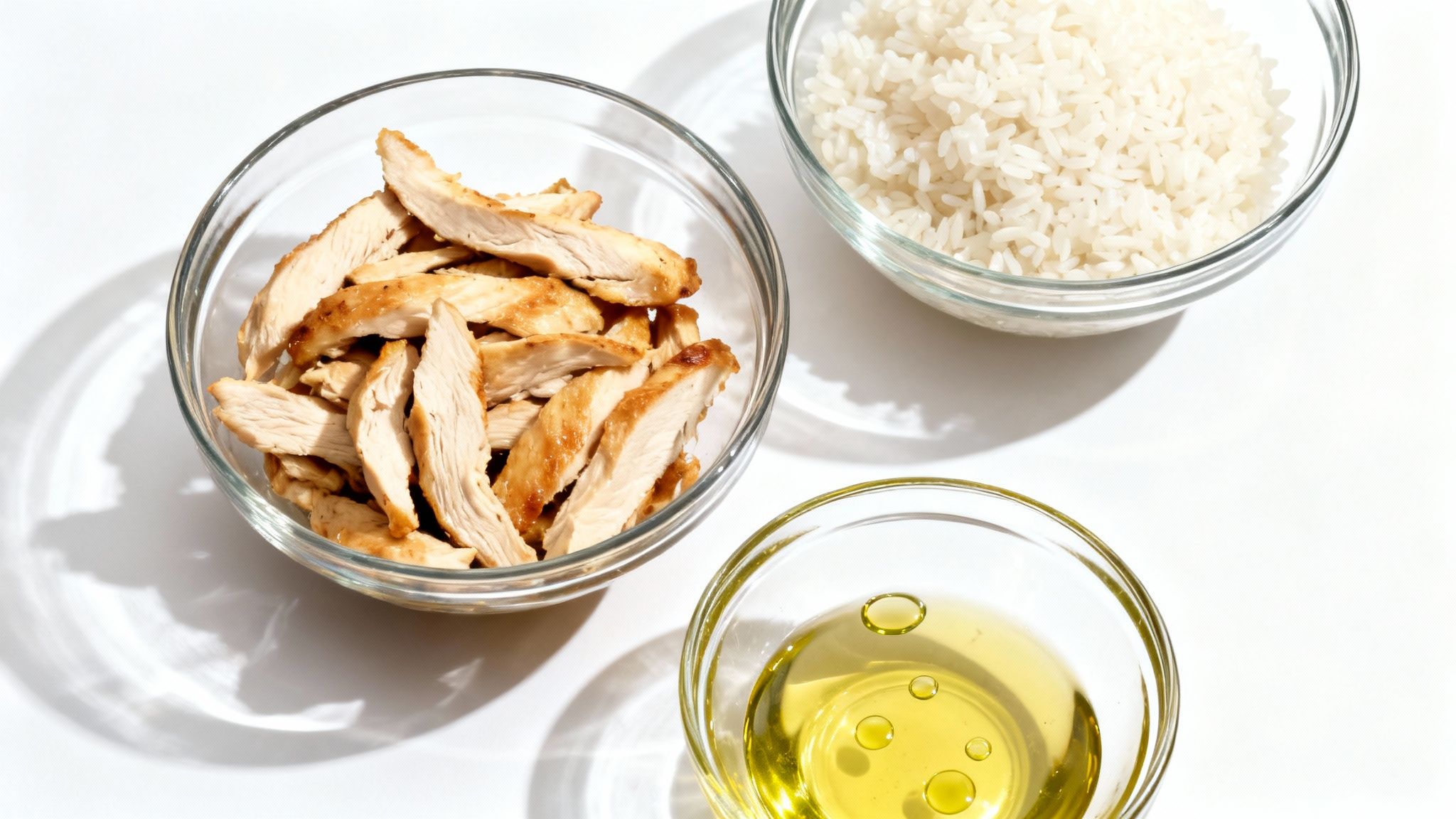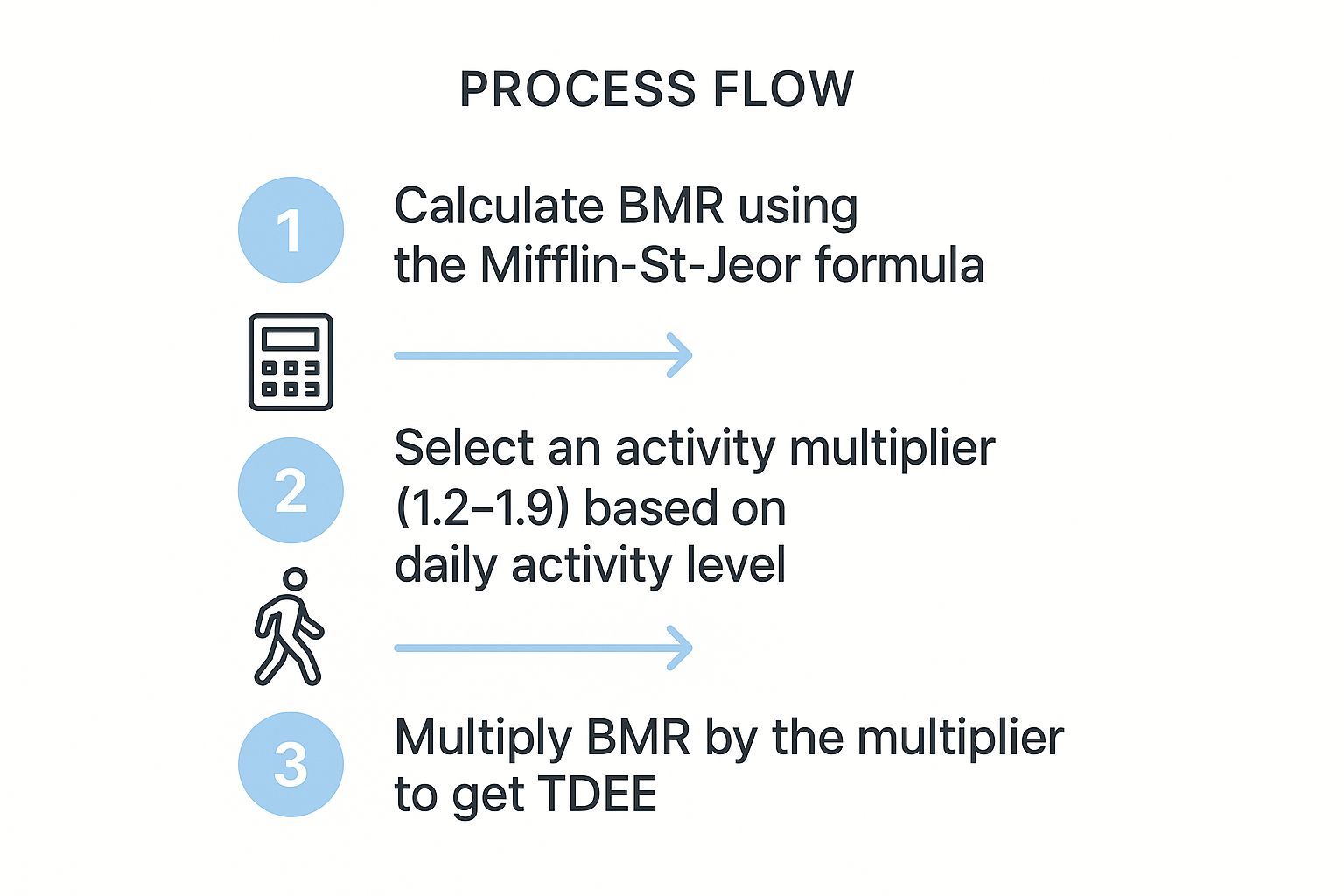Alright, let's get into the nitty-gritty of calculating your macros. It might seem like a bunch of complicated math at first, but the process is actually pretty straightforward once you get the hang of it. At its core, it's all about figuring out your daily calorie target and then slicing that pie into protein, carbs, and fats based on what you want to achieve.
Note that all claims in this article have not been evaluated by the FDA. Our products are not intended to treat or cure any diseases or conditions.
Your Foundation for Calculating Macros

Before you start plugging numbers into a calculator, it’s super important to understand why you’re even doing this. Think of macros as the fuel that powers your body for everything—from those grueling training sessions to rebuilding muscle while you rest. Every single thing you eat is made of these three components.
Getting a handle on what each one does is the first real step toward building a nutrition plan that will actually get you closer to that anime-inspired physique you're chasing.
- Protein: This is the cornerstone for muscle repair and growth. After you've pushed your limits in the gym, protein is what your body uses to rebuild those broken-down muscle fibers, making you stronger for the next session.
- Carbohydrates: Meet your body’s absolute favorite energy source. Carbs are what give you the power to push through every last rep, and they're crucial for refilling your energy stores (glycogen) after a workout so you're not running on empty.
- Fats: Dietary fats get a bad rap sometimes, but they are absolutely essential for things like hormone production and absorbing certain nutrients. They also serve as a dense, long-lasting energy source, perfect for fueling your body through the day.
The Basic Math of Macros
To really dial this in, you need to know the caloric value of each macro. This is the key that unlocks all the calculations.
Here's a quick reference table to keep in mind. We'll be using these numbers for all the math that follows.
| Macronutrient | Calories per Gram |
|---|---|
| Protein | 4 |
| Carbohydrates | 4 |
| Fats | 9 |
Knowing that fat has more than double the calories per gram compared to protein and carbs is a game-changer for how you'll structure your meals.
"The core of any effective nutrition plan is energy balance. You must first understand how many calories your body needs before you can decide how to allocate them among protein, carbs, and fats."
This isn't just about losing or gaining weight; it's about giving your body the right kind of fuel to perform like a beast. The idea of tracking macros isn't new, but it's come a long way. General health guidelines suggest distribution ranges of 45–65% for carbs, 20–35% for fats, and 10–35% for protein from your total daily calories. This thinking has shifted from just avoiding nutrient deficiencies to actively optimizing your health. If you're curious, you can learn more about the history of macronutrient recommendations and see how we got here.
This background gives you the context to make smart, informed decisions when you start to calculate your own macros.
Finding Your Daily Calorie Starting Point
Before we can even think about splitting up proteins, carbs, and fats, we need to know the size of the total "pie." That pie is your daily calorie budget, and honestly, getting this right is the single most important part of building a nutrition plan that actually works.
The goal here is to figure out your Total Daily Energy Expenditure (TDEE). Think of it as the total number of calories your body burns in a typical day, from sleeping to sprinting.
This isn't just about losing or gaining weight. It's about giving your body the right amount of fuel to function, recover from tough workouts, and build muscle. Your TDEE is your energy maintenance level. Eat more, you gain weight. Eat less, you lose weight. Simple as that.
Calculating Your Base Metabolic Rate
Our journey to finding your TDEE starts with your Basal Metabolic Rate (BMR). This is the bare-minimum energy your body needs just to stay alive at rest—think powering your brain, heart, and lungs. It's the baseline energy cost before you even roll out of bed.
One of the most trusted formulas out there for this is the Mifflin-St Jeor equation. It’s solid because it considers your sex, weight, height, and age to give a pretty accurate estimate.
- For Men: (10 x weight in kg) + (6.25 x height in cm) - (5 x age in years) + 5
- For Women: (10 x weight in kg) + (6.25 x height in cm) - (5 x age in years) - 161
This number is a crucial piece of the puzzle, but it’s not the full picture. Next, we need to account for how much you actually move.
Factoring in Your Activity Level
Your BMR doesn’t include the energy you burn walking the dog, sitting at your desk, or crushing a gym session. To get your true TDEE, we multiply your BMR by an activity multiplier that best matches your lifestyle. Be brutally honest here—overestimating your activity level is a classic mistake that will throw off your entire plan.
Finding your true maintenance calories is a process of calculation followed by observation. The formula gives you a powerful starting point, but your real-world results will tell you when it’s time to make small adjustments.
This infographic breaks down the simple three-step process to get from BMR to TDEE.

As you can see, it’s a pretty straightforward multiplication based on how active you are.
Let’s walk through a real-world example. Imagine a 25-year-old guy who is 180 cm tall (about 5'11") and weighs 80 kg (around 176 lbs). He has a desk job but hits the gym hard 4-5 days a week.
- Calculate BMR: (10 x 80) + (6.25 x 180) - (5 x 25) + 5 = 1,805 calories
- Apply Activity Multiplier: Since he trains pretty frequently, we’ll use a multiplier of 1.55.
- Find TDEE: 1,805 (BMR) x 1.55 (Activity Level) = 2,798 calories
So, his estimated maintenance level is right around 2,800 calories. This number is his anchor. From here, he can decide to eat a little more to build muscle or a little less to lean out. This calculated TDEE is the foundation we’ll build the rest of his macro plan on.
Setting Your Protein Target For Muscle And Recovery

Alright, you've got your total daily calories dialed in. Now for the most critical piece of the puzzle, especially for anyone chasing an anime-level physique: protein. This isn't just a nutrient; it's the absolute bedrock of muscle repair and growth.
Every time you crush a workout, you’re creating tiny tears in your muscle fibers. Protein is what your body uses to patch up that damage, rebuilding the muscle bigger and stronger than before. Without enough of it, you’re just spinning your wheels.
Finding Your Ideal Protein Range
Let’s cut through the noise. That old, generic advice just doesn't work for active people. To actually fuel muscle growth and proper recovery, you need more.
For most of us looking to build or maintain muscle, the sweet spot is between 1.6 to 2.2 grams of protein per kilogram of body weight. That’s roughly 0.7 to 1.0 grams per pound.
Where you should land in that range really comes down to your goal:
- Building Muscle (Bulking): When you're in a calorie surplus, you can usually get away with the lower end of the range, around 1.6-1.8 g/kg. The extra calories from carbs and fats have a muscle-sparing effect, so your body is less likely to tap into protein for fuel.
- Losing Fat (Cutting): This is where you need to ramp it up. Aim for the higher end, from 1.8-2.2 g/kg. Being in a calorie deficit puts your hard-earned muscle at risk. A high protein intake helps protect that muscle, ensuring you're losing fat, not size.
A high-protein diet does more than just build muscle—it's a secret weapon for body composition. It crushes hunger by making you feel fuller for longer, which is a massive help when you’re trying to stick to a cut.
Let's stick with our 80 kg example. His goal is to build lean mass, so he's decided to set his protein intake at a solid 2.0 grams per kilogram of body weight. This puts him right in that prime zone for growth. For a deeper dive on packing on size, our guide on how to build muscle mass has you covered.
Converting Your Target Into Calories
Now, let's translate that protein goal into actual calories. This calculation is straightforward and locks in the first part of your macro plan.
Protein in Grams: 80 kg (Body Weight) x 2.0 g/kg = 160 grams of protein per day
Protein in Calories: 160 g (Protein Target) x 4 (Calories per gram) = 640 calories from protein
Boom. He now knows that 640 calories of his daily total must come from protein. This is his number-one target every single day. Nailing this goal ensures his body has all the building blocks it needs to recover from those intense, Otaku Pump-fueled sessions and come back stronger.
Balancing Carbs and Fats for Peak Performance
Alright, you’ve locked in your total calorie target and your protein goal. Those are your non-negotiables. Now it’s time to play with the rest of your energy budget: carbs and fats.
This is where the real personalization begins. How you split these remaining calories depends entirely on your training style, your food preferences, and frankly, what makes your body feel and perform its best. This isn't just about filling a calorie gap; it's a strategic move that directly fuels your performance.
Set Your Dietary Fat Target First
Let's tackle fats first. A lot of people trying to get lean make the mistake of cutting fats way too low, and that's a huge mistake.
Dietary fats are absolutely essential for hormone production—we're talking things like testosterone, which is a major player in muscle growth. Fats also help you absorb certain vitamins and keep your cells functioning properly. Cutting them too aggressively can tank your energy and mess with your long-term health.
A great, evidence-based starting point for most lifters is to get 20% to 30% of your total daily calories from fat.
Let’s stick with our 80 kg guy who’s aiming for 2,800 calories. We'll put his fat intake right in the middle at 25% of his total calories. It's a solid sweet spot for both health and performance.
- Fat in Calories: 2,800 (Total Calories) x 0.25 (25%) = 700 calories from fat
- Fat in Grams: 700 (Fat Calories) / 9 (Calories per gram) = 78 grams of fat per day
Boom. Now he has another concrete number to aim for: 78 grams of fat each day. This gives his body what it needs for hormonal health without hogging too much of his calorie budget.
Calculate Your Carbohydrates with the Remainder
Now for the final piece of the puzzle. Carbs are your body's number-one fuel source for intense training. They're what your muscles burn through during those grueling, Otaku Pump-fueled sessions. Replenishing those glycogen stores is critical for recovery and being ready to crush it again the next day.
The math here is super simple—it's just a bit of subtraction.
Think of your remaining calories as your dedicated performance fuel. By allocating these calories to carbohydrates, you're directly investing in your ability to train harder, squeeze out that extra rep, and recover like a champ.
We just need to see what's left over after accounting for protein and fat.
- Calories Remaining: 2,800 (Total) - 640 (Protein) - 700 (Fat) = 1,460 calories for carbs
- Carbs in Grams: 1,460 (Carb Calories) / 4 (Calories per gram) = 365 grams of carbs per day
And just like that, the full macro picture is complete.
Your Complete Daily Macro Profile
Let’s pull it all together. Our example individual now has a clear, actionable nutrition plan built around his specific goal and energy needs.
- Total Calories: 2,800
- Protein: 160 grams
- Fats: 78 grams
- Carbohydrates: 365 grams
This isn't just a list of random numbers. It’s a personalized roadmap. He now knows exactly how to fuel his body to build muscle, perform at his peak in the gym, and maximize his recovery.
Tracking Your Intake and Making Smart Adjustments
https://www.youtube.com/embed/Sc4rj3OiVV8
So you've got your macro targets calculated. That's a huge first step, but a plan on paper is just that—a plan. The real magic happens when you start consistently tracking and making intelligent adjustments. This is where your numbers meet the real world, and it’s what separates those who get incredible results from those who just spin their wheels.
The point isn't to be a perfect robot hitting your numbers to the exact gram every single day. Forget that. The real goal is to gather data. Tracking gives you honest, objective feedback on what you’re actually eating, which is often a totally different story from what we think we're eating.
The Right Tools for the Job
To get reliable data, you need the right gear. Thankfully, this is easier and cheaper than ever.
- A Food Scale: This is non-negotiable if you’re serious about accuracy. Eyeballing ingredients like peanut butter or rice is a recipe for disaster. A simple digital food scale completely removes the guesswork and makes sure the numbers you log are the real deal.
- A Tracking App: Apps like MyFitnessPal or Cronometer are game-changers. Their massive food databases let you log meals in seconds. You can scan barcodes, save your favorite meals, and see your macro breakdown update in real-time.
We’re lucky to live in an era where this is even possible. Thanks to regulations like the Nutrition Labeling and Education Act of 1990 in the U.S., macro tracking is incredibly accessible. Now, over 70% of packaged foods around the globe have nutrition labels, with dozens of countries requiring them. Billions of people now have this information right at their fingertips. If you want to dive deeper, you can find more on global nutrition labeling on NCBI.
Your Body Gives the Best Feedback
Once you start tracking, your body will give you all the signals you need to make smart changes. Your macro plan isn't meant to be set in stone—think of it as a living document that should evolve as you do.
Your initial calculation is just your best-educated guess. After two to four weeks of hitting your numbers consistently, you'll have real-world data to work with: changes in your weight, your performance in the gym, and your day-to-day energy levels. Learning how to interpret this feedback is a skill, and it’s essential for getting this process right. To get a head start, check out our guide on how to read nutrition labels and master the basics.
The best nutrition plan is one that adapts. Listen to what your body is telling you—stalled weight loss, low energy, poor recovery—and don't be afraid to make small, calculated tweaks to get back on track.
When and How to Tweak Your Numbers
Adjustments should always be small and methodical. Rushing it will only mess things up. Here’s a simple framework to follow:
- Weight loss has stalled? Your calorie intake is probably a bit too high. A small drop of 150-250 calories, taken mostly from your carbs or fats, is the perfect place to start. Don't touch your protein.
- Losing weight too fast (over 1-2 lbs per week)? You're likely burning through muscle, which we don't want. Add 150-250 calories back into your day, primarily from carbs, to fuel your workouts and protect your gains.
- Feeling weak in the gym? If your performance is tanking, it's a classic sign you need more fuel. A targeted increase in carbs, especially around your workout window, can make a world of difference.
Making these small tweaks based on real results—not just how you feel on a random Tuesday—is how you guarantee your plan keeps working for you long-term. This is how you power through every single Otaku Pump-fueled workout and get one step closer to your ultimate physique.
A Few Common Questions About Macros
Once you start tracking, you're bound to have some questions. That's totally normal. Here are a few of the most common ones I hear, with some practical answers to keep you on track.
Do I Need to Hit My Macros Perfectly Every Day?
Heck no. Chasing perfection is a recipe for disaster. Obsessing over hitting every single gram is the fastest way to burn out and quit.
Think consistency over perfection. A much saner approach is to aim for a daily range. Getting within 5-10 grams of your protein and carb numbers is great. For fats, try to stay within 2-5 grams. Your two biggest priorities should always be your total daily calories and your protein goal—those two things drive the most change.
Here's a pro tip: Stop thinking of your nutrition as a daily report card. Look at your weekly average instead. If you're a bit high in fats one day, you can just pull back a little the next. It’s the overall trend that really matters.
How Should I Change My Macros on Rest Days?
Honestly, for most people, the best strategy is the simplest one: don't change a thing. Keep your macros exactly the same, every single day.
I know it sounds a little weird since you aren't training, but your off days are when the real magic happens. Your body is in full-blown repair and growth mode, rebuilding the muscle you broke down in the gym. That whole process burns a ton of energy and requires plenty of nutrients, especially protein and carbs.
Keeping your intake steady ensures your body has everything it needs to recover and come back stronger. Some elite athletes might cycle their carbs, but for the rest of us, it's just an unnecessary complication.
How Do Pre-Workouts Fit Into My Macros?
Great question, especially when you're trying to be precise. A good pre-workout supplement, like the ones we make at Otaku Pump, is designed to give you a serious performance boost without messing up your nutrition plan.
Most top-tier pre-workouts are either zero-calorie or have a tiny, insignificant amount of calories. This means you generally don't need to track them or count them in your daily macros.
Think of it as a tool for performance, not a source of food. It's there to help you crush the intense workouts that make all this nutrition tracking so effective in the first place.
What Happens If I Go Over on One Macro?
It’s going to happen, so don't stress about it. The most important thing is to stay as close as you can to your total daily calorie goal.
If you go over your fat target for the day, for example, you'll just need to pull back a bit on your carbs or protein to balance things out and stay within your calorie budget for the day.
One thing to always protect, though, is your protein goal. Protein is absolutely critical for holding onto (and building) muscle, especially when you're cutting calories. If you have to make a choice, it's much better to be a little off on your fats and carbs than to fall short on your protein. To get a better look at how it's all working together, check out our guide on how to track fitness progress and see your efforts pay off.
Ready to get more out of your workouts now that your macros are dialed in? A solid pre-workout gives you the energy and focus to make every single rep count. Check out the anime-inspired formulas from Otaku Pump to fuel your next session. Find your flavor at https://otakupump.com.




